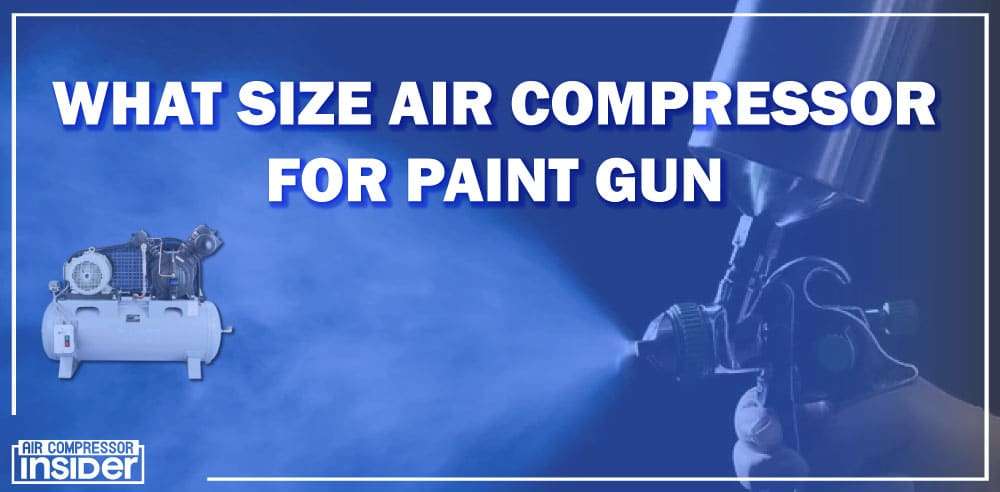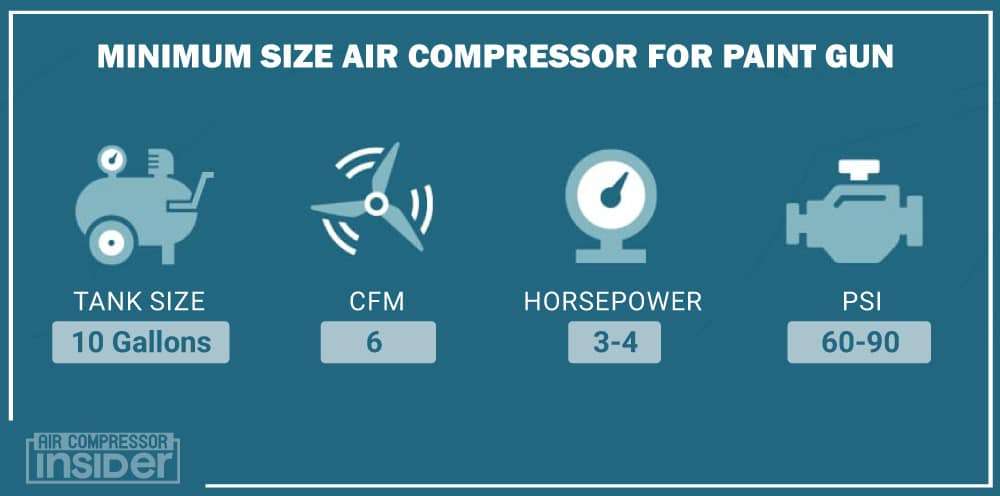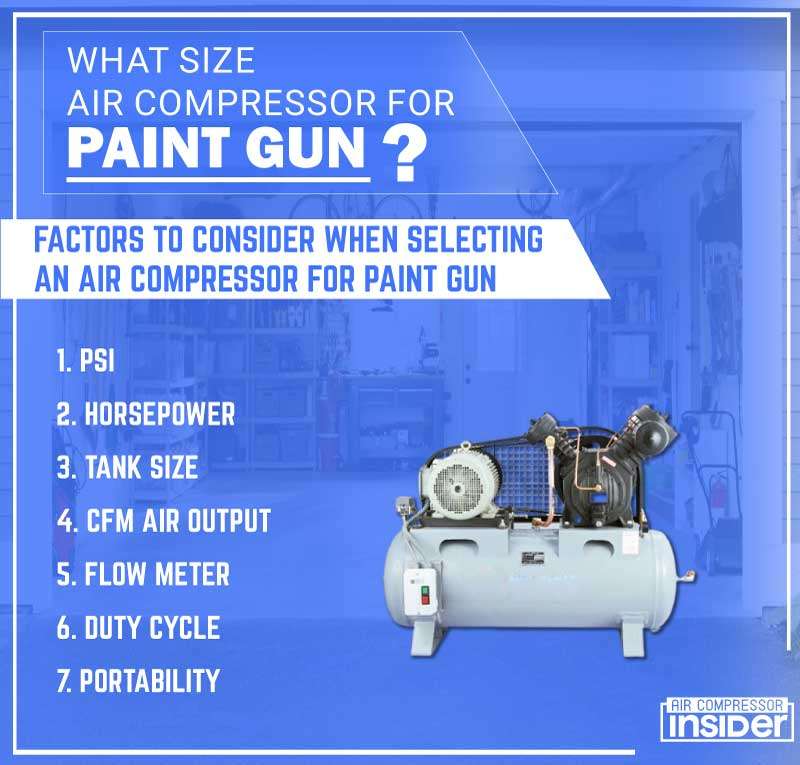Are you looking to paint your car with an air compressor, but unsure about what size would be suitable for your purpose? Don’t worry! We have got you covered with this comprehensive guide detailing all the important considerations before investing in one. Whether you are using a handheld spray gun or an HVLP system, having the right size is essential for achieving that professional finish. But what size air compressor should you get and what features do they have?
From motor power and tank size, to fill-rates and noise levels; there are several factors to consider when selecting the right air compressor for use with a paint gun. In this article, we will give our expert advice on how to pick the perfect air compressor that fits your paint gun needs.
What Size Air Compressor For Paint Gun

- What Size Air Compressor For Paint Gun
- What Is A Paint Gun?
- Types Of Paint Gun:
- Air Compressor For Paint Gun
- Can I Use Paint Gun In Multiple Projects?
- Different Uses Of Paint Guns:
- Paint Gun For Car Painting:
- Paint Gun For House Painting:
- Paint Gun For Furniture Painting:
- 7 Important Factors to Consider When Selecting an Air Compressor for Paint Gun:
- Do You Need An Compressor For Paint Gun?
- Frequently Asked Questions
- Conclusion:
For a paint gun, you’ll need an compressor with a CFM rating of at least 6 and a PSI rating of between 60-90. HP should be in the 3-4 range, and the gallon size should be around 10 gallons or higher.

What Is A Paint Gun?
A paint gun is a tool designed to spray liquid, usually paints or coatings, onto a surface. Paint guns are used in a wide variety of applications such as automotive bodywork, woodworking and even fine art.
Types Of Paint Gun:
There are two main types of paint guns:
1- Compressed Air Paint Gun
2- High-Volume Low Pressure (HVLP) Paint Gun
1- Compressed Air Paint Gun:
These are the most common type of paint guns and they use an air compressor to atomize the paint. They are great for larger projects and have a good finish, but they require more air pressure to operate than HVLP guns.
2- High-Volume Low Pressure (HVLP) Paint Gun:
HVLP sprayers are best suited for spraying lighter materials like lacquers, stains, and enamels. Conventional compressors can handle liquids of any viscosity, but they tend to be the least efficient because of the amount of air pressure needed to atomize the paint particles.
It is essential to select the right size and type of air compressor for your particular paint gun setup in order to achieve optimal results. The wrong size of compressor will not only lead to unsatisfactory painting results, but it can also damage the gun and compressor.
Air Compressor For Paint Gun
The size of an air compressor will depend on multiple factors such as the type of paint gun being used, its pressure requirements and the size of the job. The main things to consider are:
Motor Power:
A larger motor will provide more power, allowing the compressor to run longer and with higher pressure.
Tank Size:
The tank size will determine how much air the compressor can store, with bigger tanks ideal for large jobs.
Fill Rates:
This is the speed at which the air tank can be filled. A higher fill rate will result in a faster job completion time.
Noise Levels:
Some compressors are designed to be quieter than others, so if you need to paint in a quiet environment then look for one with low noise levels.
For best results, we recommend a compressor with at least 3-4 HP, an air tank of 30 gallons or more and a fill rate of 6 CFM (Cubic Feet per Minute) or higher.
Can I Use Paint Gun In Multiple Projects?
Yes, you can use your paint sprayer in multiple projects as long as you choose the right size of compressor. A larger compressor will allow you to do bigger jobs and will be more efficient for smaller ones. It is important to remember that each project may require different settings and pressure levels, so make sure your compressor has adequate adjustability.
Different Uses Of Paint Guns:
Paint guns are used in a wide variety of applications and paint spraying projects, ranging from painting cars, to furniture and even painting bikes. They can be used to apply anything from lacquers and stains, to primers and topcoats. Paint guns can also be used for touch-ups or repairs, making them an invaluable tool for any home or professional workshop.
Paint Gun For Car Painting:
When it comes to painting a car, you’ll want a compressor that is powerful enough to provide consistent air pressure and an even spray pattern. Make sure your compressor has at least 3-4 HP, an air tank of 30 gallons or more and a fill rate of 6 CFM (Cubic Feet per Minute) or higher.
For HVLP systems, you will also want to make sure that your compressor has adjustable pressure settings. This will allow you to dial in the perfect flow for each job and ensure a professional finish.
Paint Gun For House Painting:
For interior and exterior house painting, a less powerful compressor will usually suffice. A 3 HP or less compressor with an air tank of 20 gallons and a fill rate of 4 CFM should be more than enough. Again, adjustable pressure settings are important when using HVLP guns.
Paint Gun For Furniture Painting:
When painting furniture, you’ll want a compressor with at least 2 HP and an air tank of 10 gallons or more. For smaller projects such as touch-ups and repairs, even a 1 HP compressor should be sufficient. You can also use HVLP systems if desired, but the adjustable pressure settings are not necessary in this case.
7 Important Factors to Consider When Selecting an Air Compressor for Paint Gun:

Once you have chosen your paint sprayer, the next step is to select an air compressor that meets a few basic requirements. The right size and type of air compressor will depend on the pressure and volume capabilities required for your project. Here are some key factors to consider when selecting the right size air compressor:
Now let’s discuss these 7 factors one by one in detail.
Pressure Requirement for Paint Gun:
The required PSI for a paint gun will depend on the type of gun being used and the size of the job. Generally speaking, smaller jobs will require lower air pressure (eg: 20-30 PSI), while larger jobs may need higher settings (eg: 40-60 PSI). It’s important to use an appropriate amount of pressure to ensure an even, professional finish.
Horsepower Requirement for Paint Gun:
The HP of your air compressor is an important factor for running a paint gun. Light duty tasks such as furniture and touch-ups can be done with a 1-2 HP unit, while larger jobs will require at least 3-4 HP. Make sure the compressor you select has enough power to handle the job you have in mind.
Tank Size Requirement for Paint Gun:
The size of the tank on your air compressor will depend on the size of the job and how long you need it to run. For smaller projects such as furniture or touch-ups, 10 gallons or less should be sufficient, while bigger jobs may require upwards of 30+ gallons. The more air capacity your tank has, the longer it can run without having to be refilled.
CFM Requirement for Paint Gun:
This measure indicates how much air an air compressor can deliver within a certain period of time. A good rule of thumb for paint guns is 6 CFM (Cubic Feet per Minute) or higher.
Flow Meter Requirement for Gun:
The flow rate of your compressor is an important factor for running a paint gun. Larger projects may require up to 6 CFM (Cubic Feet per Minute), while smaller ones will only need around 4-5 CFM. Make sure your compressor is capable of providing adequate pressure and flow rates before investing in one.
Duty Cycle Requirement for Paint Gun:
The duty cycle of an air compressor is the amount of time you can continuously use it without overworking it and damaging the motor or other parts. Most high-quality compressors will be rated to run for 50% of the time or more, so make sure your compressor has a high enough duty cycle before investing in it.
Portability Requirement for Paint Gun:
If you plan on taking your paint gun with you on the go, then you’ll want an air compressor that is lightweight and portable. Look for units that have wheels or sturdy handles for easy transportation. It’s also important to consider the noise level of a compressor as some models can be quite loud when running.
Do You Need An Compressor For Paint Gun?
Yes, an air compressor is necessary for running a paint gun. The size and power of the compressor you need will depend on the type of job you are doing, as well as the PSI and flow rate requirements. Make sure that your compressor has adjustable pressure settings – this will ensure a professional finish every time! Additionally, consider portability and noise level when selecting an air compressor. With the right unit, you’ll be able to paint your car with confidence!
Frequently Asked Questions
Question #1
What are the requirements for furniture painting?
For furniture painting, you’ll want a compressor with at least 2 HP and an air tank of 10 gallons or more. For smaller projects such as touch-ups and repairs, even a 1 HP compressor should be sufficient. You can also use HVLP systems for furniture painting.
Question #2
What size air compressor do I need for large jobs?
For larger jobs such as car painting, you’ll want an air compressor with at least 3-4 HP and a tank of 30+ gallons. Additionally, make sure that the flow rate is high enough, look for models with 6 CFM or more.
Question #3
How do I ensure an even finish?
To ensure an even finish, use the appropriate amount of pressure. Start with lower pressure settings (eg: 20-30 PSI) and adjust according to the job, while larger jobs may need higher settings (eg: 40-60 PSI). It’s also important to ensure that your compressor has adjustable pressure settings so you can tailor it to the type of job you are doing.
Question #4
Do I need a duty cycle rating for paint guns?
Yes, duty cycle ratings are important when selecting an air compressor for paint guns. Make sure that your unit is rated at least 50% or more if you plan to use it for long periods of time.
Question #5
Is portability important?
If you plan on taking your air compressor with you from job to job, then portability is an important consideration. Look for models that have wheels or sturdy handles for easy transportation. Additionally, consider the noise levels of a compressor – some models can be quite loud when running so make sure that yours isn’t too noisy for your needs.
Question #6
What are the safety considerations when working with paint guns and compressors?
It’s important to ensure that all hoses and connections are secure before using a paint gun with an air compressor. Additionally, wear protective gear such as face masks, goggles, and gloves as paint particles can be dangerous. Make sure that the area you are working in is well-ventilated to avoid noxious fumes.
Question #7
What should I look for when purchasing an air compressor?
You’ll want to make sure that your air compressor has adjustable pressure settings, a high duty cycle rating, adequate power and flow rate for your needs, and is portable if necessary. Additionally, consider any additional features such as noise levels before investing in one.
Question #8
How often should I lubricate my air compressor?
It’s important to keep your air compressor properly lubricated according to the manufacturer’s instructions. Most compressors require oil changes at least once a year, while others may need more frequent lubrication. Consult the owner’s manual for precise instructions on how often to lubricate your compressor.
Question #9
How do I store my air compressor properly?
Air compressors should be stored in cool, dry places away from direct sunlight and moisture. Additionally, clean any dust or debris off of the surface of the unit before storing it away to protect it from corrosion and damage.
Question #10
What is the best way to use an air compressor for painting cars?
Start by prepping the car – sanding, cleaning, and priming where necessary. Then choose your paint gun – HVLP systems are best for painting cars as they use less pressure and produce a more even finish. Once you have your equipment ready, adjust the air compressor’s pressure settings according to the type of paint job you are doing and start spraying! Always remember to wear protective gear when working with paint guns.
Conclusion:
Paint guns and air compressors are essential tools for various painting projects. When choosing an air compressor, make sure to consider what size air compressor for paint gun is needed to carry out your painting job. Also check the required duty cycle rating, adjustable pressure settings, portability, and noise levels. Additionally, take precautions such as wearing protective gear, regularly lubricating your compressor, and properly storing it when not in use. With the right equipment and safety steps taken, you’ll be able to successfully use paint gun with ease!
